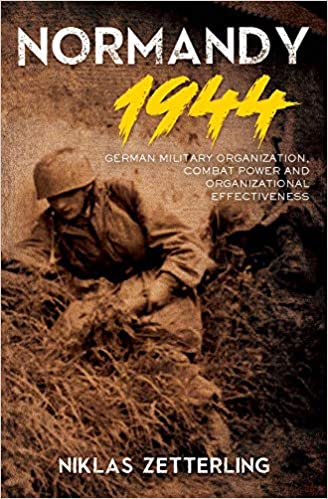
Reviewed by Col Jody Owens.
The Allied forces began Operation Overlord on June 6, 1944. The battle continued until late August with the escape of German forces through the Falaise Gap. This roughly three-month clash became one of military history’s most famous battles. In the 76 years since the pitched battle occurred, countless historians, military officers, and enthusiasts around the world have written about it. Researchers have examined most aspects of the battle including Allied and German leadership, strategies, tactics, logistics, deception plans, and many more. Despite the myriad of histories, accounts, and stories, authors continue to produce new research and interpretations of existing records regarding the battle.
One such account comes from Niklas Zetterling in his manuscript Normandy 1944: German Military Organization, Combat Power and Organizational Effectiveness. Zetterling, a Swedish author who has already published multiple non-fiction books examining Germany throughout WWII, addressed elements of the battle that he felt lacked enough examination. These included the overall German order of battle, the accounting of German casualties, and the numerous myths surrounding the organization of the German units. Zetterling highlights the challenge of finding suitable sources as German record-keeping at the lower unit-levels was particularly lax as the battle progressed. However, through his research and analysis, he successfully expanded the codex of knowledge regarding German military capabilities utilized.
Zetterling began his examination by establishing terms of reference for how the Germans reported manpower strengths. This is important for interpreting the combat power of the units involved. For example, the Germans tracked a variety of measures of unit strength including ration strength, actual strength, daily strength, combat strength, and front strength. Each measured a different component of a unit’s manpower capability and varied greatly between types and levels of units (e.g. headquarters vs. combat units). Staffs at the army or army group level often reported inflated ration strength numbers that had little to do with a unit’s combat strength as it included non-combat units in the reports such as supply, propaganda, and other units. By contrast, the division and below units better reflected their ration strengths because they rarely had non-combat elements attached. Zetterling illustrates that the quality of the reporting makes it very difficult to make an apple to apples comparison of German manpower strengths and unit organization across the many entities that participated in the battle.
Next, Zetterling provided an in-depth description of how the Germans organized their combat units. Zetterling dedicates over 250 pages to the detailed accounting of combat strengths for each unit by formation type, including General Headquarters Artillery, miscellaneous General Headquarters, General Headquarters Panzer, Infantry Divisions, and Panzer Divisions. Zetterling’s level of detail exemplifies his high degree of research and the challenge he faced to create an exhaustive accounting of the German combat units in Normandy.
Zetterling also conducted research to help dispel or confirm, a variety of myths surrounding German combat power. First, he sought to clarify the number of German soldiers employed during the campaign. He argued that historians often exaggerate the number of soldiers involved or inaccurately interpret the records (exacerbated by the difficulty in the terminology for unit strengths) and improperly account for them. Zetterling determined that approximately 640,000 German soldiers were involved in the campaign, which falls somewhere in the middle compared to numbers proffered by other authors that Zetterling discussed. He highlights their numbers to be 540,000 to over one million soldiers that served in Normandy.
Next, Zetterling tackled the number of German losses in Normandy. According to Zetterling, British literature often sets German losses at 450,000 men (210,000 prisoners, 240,000 killed and wounded). Zetterling produced starkly different numbers. From June to August 1944 in the entire Western theater (includes all of France), he found the Germans had 23,019 men killed, 67,060 wounded, and 198,616 captured. These figures reflect the differing conditions in France compared to those in Russia. In France, German fuel shortages made it more difficult for troops to retreat, and the soldiers were more inclined to surrender than those fighting in Russia. These conditions also aligned with equipment losses. Zetterling highlights that of the 2,336 tanks, tank destroyers, and assault guns sent to Normandy, the Germans lost about 1,500 of them, with at least half of the losses due to fuel and repair issues, not Allied fire.
One area Zetterling falls short is visualization of his findings. Displaying the German units and their corresponding strengths on a map with a timeline of the battle would be very useful for understanding how the battle played out and to see the effects of German combat strength. Overall, I enjoyed reading this book and it fills a very niche need in the historical annals of Operation Overlord. Zetterling did not attempt to rewrite the history of the engagement between the Allied and German forces. Instead he helps to paint a picture of the organizational effectiveness of the German military that the Allied forces faced. I highly recommend it for those looking to better understand the German order of battle and the role the German unit organization played in this historic campaign.
Normandy 1944: German Military Organization, Combat Power and Organizational Effectiveness, by Niklas Zetterling. Casemate, Philadelphia and Oxford, 2019. 402 pp.
Reviewed by Col (Dr.) Jody Owens, USAF (Assistant Professor, Joint Forces Staff College).
Purchase your copy today! amzn.to/3kKmDWI

